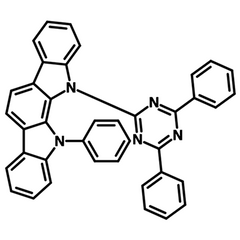DIC-TRZ
CAS Number 1024598-01-3
High Purity Sublimed Materials, Host Materials, Materials, OLED Materials, Phosphorescent Host Materials, Semiconducting Molecules,Bipolar TADF Host Material
TADF host, phosphorescent host, and hyperfluorescence host, DIC-TRZ, 11-(4,6-Diphenyl-1,3,5-triazin-2-yl)-12-phenyl-11,12-dihydroindolo[2,3-a]carbazole, CAS No. 1024598-01-3, Sublimed ≥99.0%
Specifications | MSDS | Literature and Reviews | Related Products
Featuring a high bandgap of 3.1 eV and a small ΔEST of 0.06 eV, DIC-TRZ is commonly used as bipolar TADF host for highly efficient OLED devices. It has a structure of an electron-donating indolo[2,3-a]carbazole (23aIC) unit and an electron-accepting diphenyl-1,3,5-triazine (TRZ) unit. A green phosphorescent OLED based on T3PyTRZ as the electron transport and DIC-TRZ as the host simultaneously achieves a low turn-on voltage at 1 cd/m2 of 2.18 V, a high EQE of over 24%, a high power efficiency of over 115 lm/W. Even at a high brightness of 1000 cd/m2, the driving voltage was only 2.88 V.
A three-component light-emitting layer consisting of DIC-TRZ as the host, Ir(piq)3 as the phosphorescent assist dopant, and Pt(tpbp) as the phosphorescent emitter simultaneously demonstrates high efficiency and long lifetime in the NIR. Efficient energy transfer between the two phosphorescent materials can be realized with 1 wt% doping ratio of the NIR emitter to significantly enhance the external quantum efficiency reaching 10.5% with an emission peak at 769 nm. The device shows a low drive voltage and a long operational lifetime, with a luminance decay of less than 11% from the initial value after 4800 h under accelerated conditions of 100 mA cm-2.
The hyperfluorescence OLED based on phosphorescent emitter Ir(ppy)3, DIC-TRZ as the host, and 𝜋-extended asymmetric MR-TADF molecule PhPXZ-tCzBN as the emitter demonstrates an outstanding device performance with a high PE of 150 lmW-1, an EQE of 27%, and a long lifetime LT95 of over 3000 h at 1000 cd m-2.
DIC-TRZ can also be used for highly sensitive room temperature ammonia gas sensing with low detection limit in the ppb-range, fast response and recovery time, and stable operational current.
General Information
| CAS Number | 1024598-01-3 |
|---|---|
| Full Name | 11-(4,6-Diphenyl-1,3,5-triazin-2-yl)-12-phenyl-11,12-dihydroindolo[2,3-a]carbazole |
| Chemical Formula | C39H25N5 |
| Molecular weight | 563.65 g/mol |
| Absorption | n.a. |
| Photoluminescence | 500 nm (in film) |
| HOMO/LUMO | HOMO = - 5.8 eV, LUMO = - 2.7 eV (ΔEST = 0.06 eV) |
| Classification/Family | Indolo[2,3-a]carbazole derivatives, TADF Host materials, Phosphorescent host materials, OLEDs |
Product Details
| Purity | Sublimed > 99% |
|---|---|
| Melting Point | N/A |
| Appearance | White powder/crystals |
Chemical Structure

Device Structure(s)
| Device structure | ITO (100 nm)/Polymer Buffer* (20 nm)/NPD (10 nm)/4DBFHPB* (10 nm)/DIC-TRZ:20 wt.% Ir(ppy)3:5 wt.% PhPXZ-tCzBN (30 nm)/DBF-TRZ (10 nm)/20 wt.% Liq-doped T3PyTRZ (40 nm)/Liq (1 nm)/Al [4] |
|---|---|
| Color |
 Green Green |
| LT90@1000cd m-2 | 8632 h |
| Turn on Voltage (Von) | 2.15 V |
| CIE Coordinates | (0.35,0.63) |
| Max Current Efficiency | 110.6 cd/A |
| Max Power Efficiency | 150.3 lm/W |
| Max EQE | 27.6% |
MSDS Documentation
Literature and Reviews
- D. Zhang et al. (2014); High-efficiency fluorescent organic light-emitting devices using sensitizing hosts with a small singlet-triplet exchange energy, 26 (29), 5050-5055; DOI: 10.1002/adma.201401476.
- T. Kawano et al. (2023); Tetrapyridine/triphenyltriazine-conjugated electron transporters for low-power-consumption, high-stability phosphorescent OLEDs, J. Mater. Chem. C, 11, 4129-4135; DOI: 10.1039/D2TC04647D.
- T. Hanayama et al. (2024); Near-infrared phosphorescent OLEDs exhibiting over 10% external quantum efficiency and extremely long lifetime using resonant energy transfer with a phosphorescent assist dopant, Appl. Phys. Express, 17, 044002; DOI 10.35848/1882-0786/ad3725.



